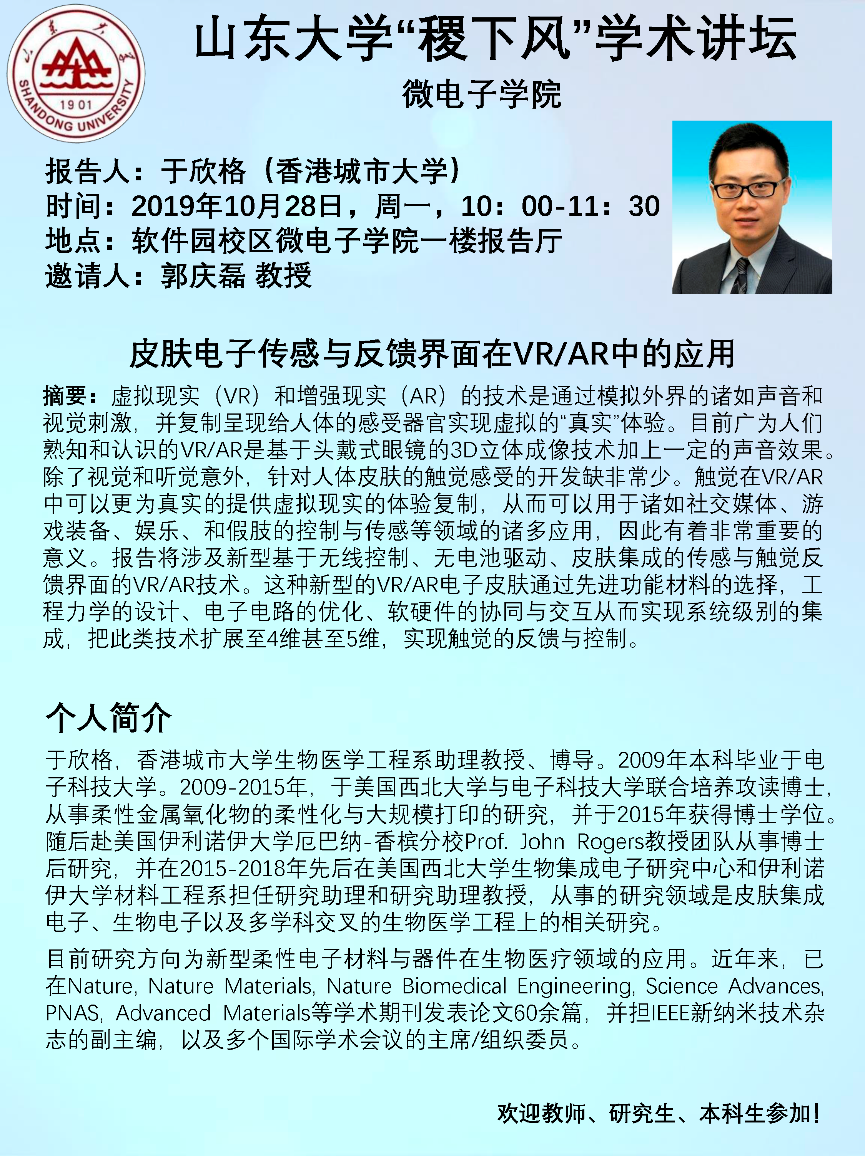
Lecture:Skin-integrated wireless haptic interfaces for virtual and augmented reality
Speaker: Dr. Xinge Yu,City University of Hong Kong
Inviter: Prof. Qinglei Guo
Date:October 28, 2019
Time:10:00-11:30 a.m.
Location:Lecture Hall on the first floor, School of Microelectronics, Software Park Campus
Abstract:
Traditional technologies for virtual reality (VR) and augmented reality (AR) create human experiences through visual and auditory stimuli that replicate sensations associated with the physical world. The most widespread VR and AR systems use head-mounted displays, accelerometers and loudspeakers as the basis for three-dimensional, computer-generated environments that can exist in isolation or as overlays on actual scenery. In comparison to the eyes and the ears, the skin is a relatively underexplored sensory interface for VR and AR technology that could, nevertheless, greatly enhance experiences at a qualitative level, with direct relevance in areas such as communications, entertainment and medicine. This report presents a wireless, battery-free platform of electronic systems and haptic (that is, touch-based) interfaces capable of softly laminating onto the curved surfaces of the skin to communicate information via spatio-temporally programmable patterns of localized mechanical vibrations. We describe the materials, device structures, power delivery strategies and communication schemes that serve as the foundations for such platforms. The resulting technology creates many opportunities for use where the skin provides an electronically programmable communication and sensory input channel to the body, as demonstrated through applications in social media and personal engagement, prosthetic control and feedback, and gaming and entertainment.
Bio:
Xinge Yu, Assistant Professor and Ph.D. Supervisor, Department of Biomedical Engineering, City University of Hong Kong. He graduated from the University of Electronic Science and Technology (UEST) with a bachelor's degree in 2009. From 2009 to 2015, he pursued his Ph.D. in the joint training of Northwestern University and the University of Electronic Science and Technology (UEST), working on the research of flexible metal oxides for flexibilization and large-scale printing. He then went to the University of Illinois at Urbana-Champaign for postdoctoral research in Prof. John Rogers' group, and worked as a research assistant and research assistant professor at the Center for Biointegrated Electronics at Northwestern University and the Department of Materials Engineering at the University of Illinois from 2015-2018, working in the fields of skin-integrated electronics, bioelectronics, and interdisciplinary biomedical engineering.
His current research focuses on the application of new flexible electronic materials and devices in the field of biomedical engineering. In recent years, he has published more than 60 papers inNature Materials,Nature Biomedical Engineering,Science Advances,PNAS,Advanced Materialsand other academic journals. He is also an Associate Editor of the IEEE Journal of New Nanotechnology, and chair/organizing member of several international conferences.